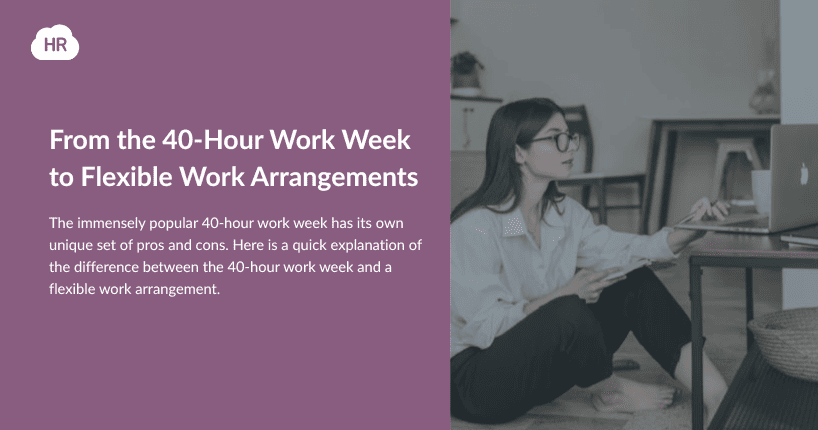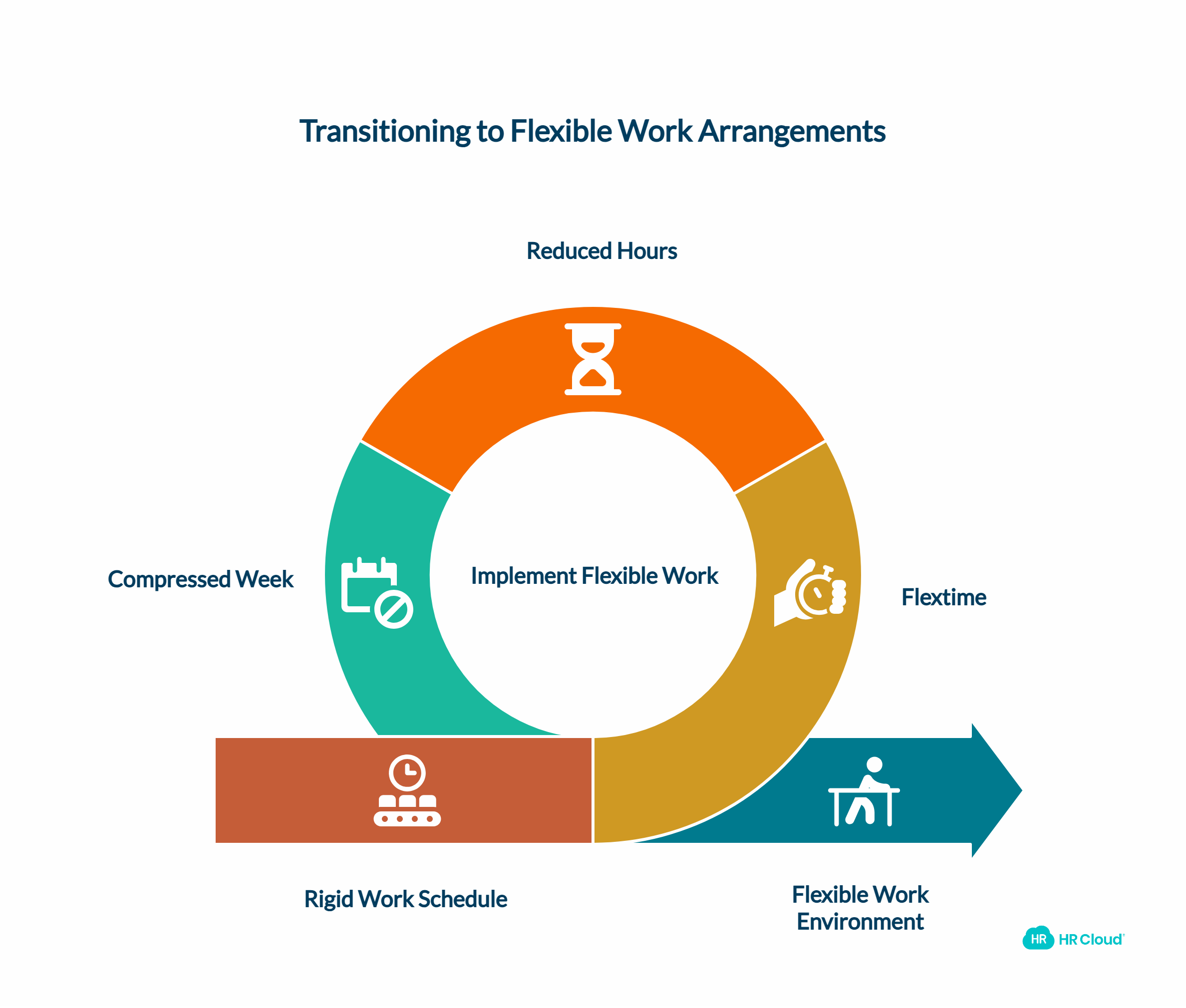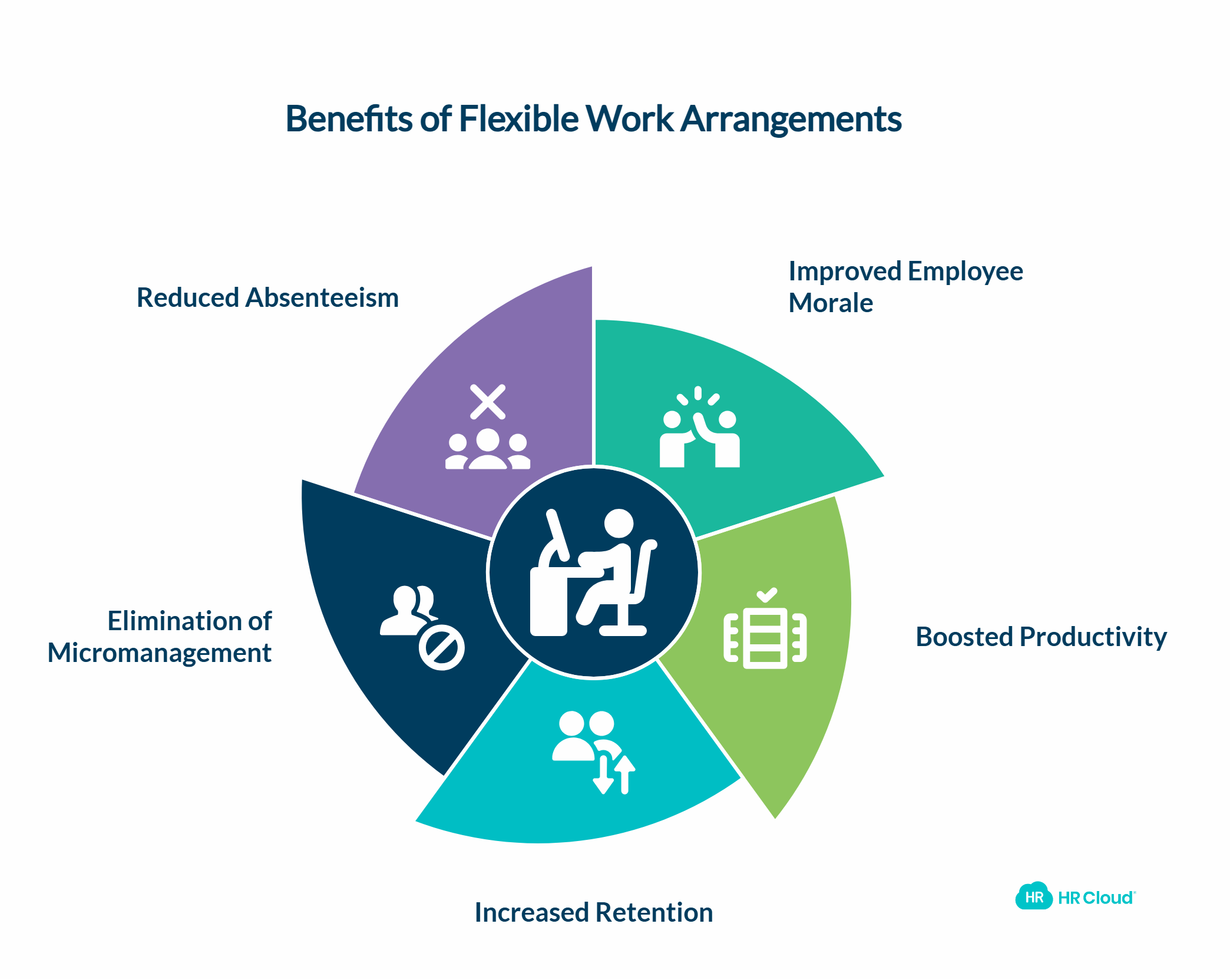From the 40-Hour Work Week to Flexible Work Arrangements



 Cut onboarding time
by 60%—here's the
Ultimate Checklist
that helped do it.
Cut onboarding time
by 60%—here's the
Ultimate Checklist
that helped do it.

The immensely popular 40-hour work week has its own unique set of pros and cons. For example, such a standardized schedule allows employees to maintain a routine and promotes accountability. However, the downside is that it causes an unhealthy work-life balance, particularly in today's environment, where the global pandemic has caused telecommuting and hybrid work models to become the norm.
So, in the interest of boosting employee satisfaction, engagement, and productivity, employers need to look at unconventional methods for running their businesses. One such method is to implement flexible working options
Read the rest of this article as we discuss the reasons why you should switch from a 40-hour work week to flexible working hours for your employees. But first, a quick explanation of the difference between the 40-hour work week and flexible work arrangements.
40-Hour Work Week Vs Flexible Work Schedule
Before beginning our discussion of the benefits of flexible work arrangements, we first have to understand what makes it different from a 40-hour work week. Once we understand the differences, the benefits become much more apparent.
What is the 40-Hour Work Week?
Established by Congress in the Fair Labor Standards Act of 1940, the 40-hour work week is considered to be the standard amount of time employees are required to work.
It's a standardized schedule that comes with many benefits, such as:
-
It Helps Employees Maintain a Routine: Employees working from 9 to 5 Monday through Friday know they've got the weekend off, which allows them to plan their personal time and appointments around that schedule.
-
It Promotes Employee Accountability: When employees know that they have to arrive at work at a certain time each day and get their tasks done by a specific time, they are more accountable.
-
Establishes Great Communication: When all employees in the workplace have a set work schedule, they have access to all other members of staff for easy collaboration and communication. They might use email, Windows messaging, or Slack.
However, while the 40-hour work week is a common concept that has been adopted by countless businesses across the globe, it isn't necessarily the best schedule for all employees.
Some may find this type of schedule too constricting. They may feel that having a set number of days and hours within which to complete their work limits the amount of time they can spend with their families, running errands, or exploring hobbies.
On the other hand, having a flexible work environment may be more appealing. In fact, studies show that over a third of company workforce location plans for the last year were focused on a mix of hybrid and fully remote work models.
What is a Flexible Work Arrangement?
Simply put, a flexible work arrangement is an alternate schedule from the typical working day and week. Time flexibility allows workers the opportunity they require to do other things during the day that they wouldn't be able to do working a traditional 9 to 5 schedule.
For example, it used to be that when someone went to work at 9, they stayed in the office space until 6, went home, and did it all over again the next day. If they had a doctor's appointment or a kid's soccer game in the middle of the day, their only options were to either skip it or take the day off. But with flexible working hours, employees have the flexibility to meet personal and family commitments and tend to life circumstances without the anxiety and worry that used to accompany such situations. They can finish out the day by working a little later into the evening once they get home.
Work from home is one form of flexible arrangement. Other examples of flexible work include:
-
Flextime: Flextime is an arrangement where workers can put in a full day's work, but they have the ability to vary working hours according to their individual situations.
-
Reduced Hours/Part-Time: This type of work arrangement allows employees to choose to work fewer than the standard 40-hour work week, whether on a temporary or permanent basis. This is a great option for employees with disabilities or health problems.
-
Compressed Workweek: This work model allows employees to work for longer periods of time each workday in exchange for a day off.
Not only are flex schedules the new norm, but they've also been shown to provide a wide range of benefits, particularly to talented, self-motivated employees who find that type of work environment conducive to improved morale and enhanced productivity.
Below, we take a look at 5 reasons why you should switch to flexible work arrangements.
Reasons for Switching to a Flex Work Arrangement
Now that you understand the difference between a 40-hour work week and flexible work conditions, let's take a look at some of the reasons you might consider making the switch.
-
1. Improve Employee Morale
-
Alternative working time arrangements can help boost employee morale and overall job satisfaction at work. Increased job energy and creativity are additional benefits to granting your employees the ability to work more flexible hours. When employees get to work in a way that best fits their needs, they'll be able to focus their time productively on work-life integration, increasing their sense of autonomy, happiness, and satisfaction within the company. Ultimately, this will give them the ability to handle stress in a much better way, contributing to better mental health.
2. Boost Overall Productivity
Just a few years ago, if anyone had said that people working remotely could be just as productive as those working in office settings, that comment might have been met with tons of mocking derision.
However, technology has shattered this myth of workers needing to trek to offices every day in order to collaborate effectively on projects.
Now, this type of flexible work environment has been shown to promote productivity by allowing employees to spend their time more productively, ensuring that employees are meeting deadlines, productivity goals, etc., instead of making sure they’re “putting in the time.”
Moreover, some employees are more productive early in the morning, whereas others find they can get the most work done efficiently during the late afternoon.
Let them determine for themselves what their most productive time is, so you can get the most from their work hours.
Assaf Cohen, who runs gaming company Solitaire Bliss, believes autonomy is a major part of why remote teams are productive. “We found that when we went remote, we became more deadline and milestone-oriented with our game development. Our employees loved the fact that we trusted them to manage their own time, and it resulted in significant productivity gains.”
3. Increase Retention
Another benefit to implementing flexible working options is that it allows you to offer more appeal to talented candidates who will then be likely to remain at the company for an extended period of time.
When companies provide flexible work arrangements for employees, it attracts top-tier talent to the workplace. You’re also likely to notice an increase in productivity from current employees who are given the option of flex time.
They will strive to boost their productivity after moving to a flexible work schedule in order to prove that they are still valuable to the team and to show gratitude to the employer for offering them a path to a happier work-life-family balance. This focus on employee satisfaction and work-life integration can significantly improve employee retention rates.
4. Eliminate Micromanagement
As the global workforce enjoys more flexible work conditions, managers are beginning to notice a drastic reduction in the need to micromanage workers.
More and more people are finding ways to manage a happy balance between their work and personal life without dropping the ball at work.
Some managers may feel that teleworking limits their ability to oversee employees since some employees working from home may be available later or earlier than others. For example, an in-office assistant may only be able to complete work during regular business hours, but a virtual assistant hired remotely is more able to complete late-night or weekend tasks as needed without having to leave their living room or at-home office.
This is true of many other positions as well. A flexible work arrangement allows employees to have more autonomy, which means there's a decreased need for the type of micromanagement typically associated with the 40-hour work week and an increased amount of productivity among workers who can work whenever and wherever is most convenient for their work-life balance.
With the right plan in place, you'll be able to keep track of employees’ work progress and build professional and communicative relationships with them regardless of their flex schedule. In addition, consider virtual phone systems, email, and communication tools like messaging apps and video conferencing for better collaboration.
Ultimately, this will help you create a more conducive workplace culture and focus more time on growing the business instead of micromanaging remote workers.
5. Reduce Absenteeism
Yet another benefit of implementing flexible work arrangements is that it allows you to dramatically reduce absenteeism.
As previously mentioned, when people work from 9 to 5, they typically have to take the day off in order to be able to take care of personal issues that occur during the workday.
For example, if one of their kids has a late afternoon dance recital, their only options are to either skip the recital or take the day off.
But with flexible schedules, people can meet their personal or family obligations, and once their life circumstances have been tended to, they can simply get back to work and possibly put in a few extra hours to ensure that their work tasks are finished on time. This concept of time-off reduces the chances of leaves to be taken by the employees.
Conclusion
There are some considerations that should be taken before jumping into flexible work policies for remote workers. When working remotely and outside normal business hours, there is often an increased need to ensure that data used by employees is stored securely and not shared with third parties. This might mean revising employee contracts or privacy policies to ensure that access to company data off-site is done in a secure way that protects customers and other stakeholders. Nonetheless, once you take the proper precautions, flexible work arrangements offer numerous benefits for your employees who will have the flexibility to better balance personal and family obligations during the workday. This, in turn, will lead to a more satisfied and motivated workforce, less turnover, and a healthier company culture within the organization.
If you are considering joining the countless companies that are reinventing work with strategic flexible work models, then use the information in this article to make the best choice for your business so you can keep your employees engaged, productive, and loyal to your company. Embracing these changes could give you a competitive advantage in the labor market and position your organization at the forefront of the future of work.
Are you ready to wave bye-bye to the 40-hour work week and embrace more flexible working options for your employees? Sound off below!
FAQ's
1. What is the difference between a 40-hour work week and flexible working hours?
Ans: A 40-hour work week follows a fixed Monday-to-Friday schedule, typically 9 to 5. Flexible working hours allow employees to choose when they work, as long as results are delivered—offering more autonomy and better work-life balance.
2. Why are companies moving away from the traditional 40-hour work week?
Ans: The rise of remote work, employee burnout, and a demand for autonomy are pushing companies to adopt more flexible work policies. Studies show that flexibility improves morale, reduces absenteeism, and increases retention.
3. What are the most common types of flexible work arrangements?
Ans: Popular options include flextime, compressed workweeks, part-time roles, and remote or hybrid schedules. Each model provides a different way for employees to manage time more effectively.
4. Does a flexible work schedule actually improve productivity?
Ans: Yes. Many organizations report increased productivity due to less commuting time, fewer distractions, and employees working during their peak hours. Flexibility also reduces micromanagement and boosts accountability.
5. What challenges should businesses consider before implementing flexible work policies?
Ans: Companies must address data security, employee monitoring, communication protocols, and clear performance expectations. Updating contracts and ensuring secure remote access are also key.
 Discover how our HR solutions streamline onboarding, boost employee engagement, and simplify HR management
Discover how our HR solutions streamline onboarding, boost employee engagement, and simplify HR management
Author:
Ron Stefanski is a website entrepreneur and marketing professor who has a passion for helping people create and market their own online business. You can learn more from him by visiting OneHourProfessor.com
You can also connect with him on YouTube or LinkedIn.
Keep Reading
15 Proven Ways to Create a Healthy Work Environment (2026 Guide)
A healthy work environment is a workplace where employees experience psychological
Best Workday Alternatives for Mid-Market Companies in 2026: Complete HRIS Comparison Guide
"We implemented Workday and our HR team still can't figure out half the features six
Company Culture Software: How to Build a Thriving Workplace in 2026
Ask any business leader what drives lasting organizational success, and you'll hear
Like What You Hear?
We'd love to chat with you more about how HR Cloud® can support your business's HR needs. Book Your Free Demo

Build a Culture of Recognition. Boost Engagement. Guaranteed.
Workmates empowers employees to stay informed, connected, and appreciated—whether they’re on the front line, in the office, or remote. Recognition drives 12x higher engagement.Trusted by industry leaders in every sector




Cut Onboarding Costs by 60%.
Take the confusion and follow-ups out of onboarding with automated workflows, digital forms, and structured portals—so new hires ramp faster 3X quicker.Trusted by industry leaders in every sector




